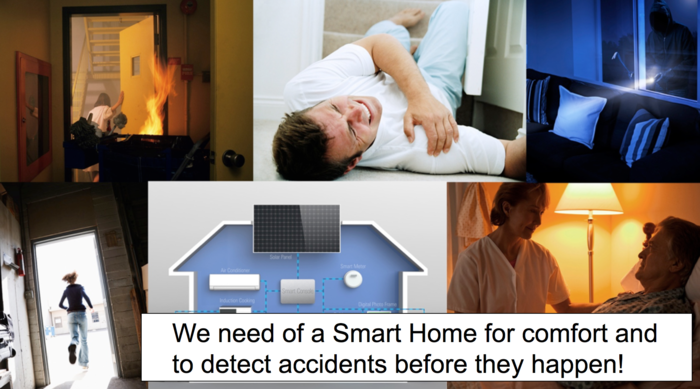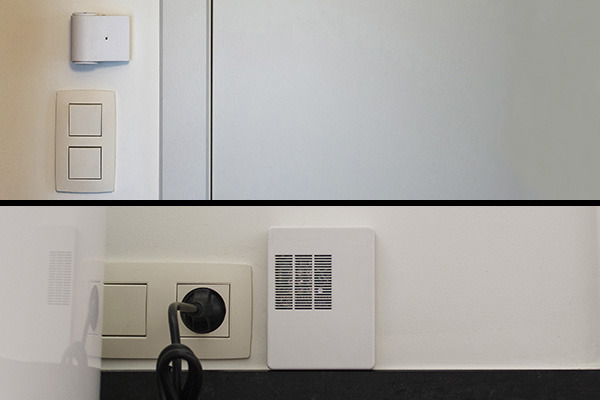@home: Make Home Truly Smart
Created 1 | Supported 19
63 of 50
2851124
Social ReachCompleted
Ended 02/25/2015"A #SmartHome is more than just lights & heating. It is about people! Support @home #crowdfunding #IoT http://hdtk.co/wuZMk"
— Francesco Pessolano and 63 other supporters
Share | How It Works | Embed
Introducing @home
There is a need for a smart home that can adapt itself in order to make our life more comfortable. That can control lights, turn on the TV if you sit on the sofa, turn off the alarm as you stand up. There is an even greater need for a smart home that can detect a dangerous situation. A home that can let us know if an accident has or is about to happen. Imagine our kids sleepwalking, or our elderly parents living alone at home. It will make their lives safer and ours with fewer worries.

Such a home needs to know where people are in the house with high precision and without the need for a person wearing or carrying any sort of tracking device. No smartphone. No Bracelet. No Tag. This is what @home does by means of sensors on walls that can sense and track people in real-time, with high precision (30cm or 12’’) and without anything to be carried around. We have already released a product based on a limited version of this technology two years ago. It is today being used by Nursing Homes and Hospitals to make sure their guests do not suffer accidents such as falls or sleepwalking.
Now that the technology is mature, we want to make it available for everyone.
What can you do with it?
Out of the box, one @home kit contains four sensors that are enough to monitor a room up to 8m x 8m (33' x 33'). It can detect a given set of events among which: change in number of people in the room, a person getting in or out bed, a person laying down or kneeing, a person entering or exiting the room, a person walking around. You can set the system to send such events as notification to a smartphone or home automation system, and/or to be stored in order to be analysed later with our "Event Viewer" software to see if something unusual has happened such as a kid sleepwalking.
With a single @home kit most rooms and events can be covered without problems. There can be cases, however, when only 3 or 2 sensors are needed. For example, if you need to control small spaces or activity in front of a door. There can be cases when 5 sensors are needed. This is with irregular rooms and when it is needed to know the position everywhere in the room. If you have more than one kit, you can link them in a house configuration allowing not only detection of more complex events as well as tracking of people as they move freely in the house. Imagine the possibilities! For example, you can let lights and appliances react based on what you are doing in the house.
Wait a sec, I can think of more things it could do!
Yes, you can do more with @home!
First of all, we will provide you an “Event Editor” to define your own events to be notified. Events are defined with simple rules expressing IF-THEN-ELSE conditions based on number of people present, their position, furniture position in the room and so on. For advance users we are planning to add support for IFTTT recipes, at least, for integrating of our localisation systems and event notification with third-party automation and detection systems. For developers, we will provide direct WIFi access to raw data such as person location, number of people per room and room topology. With such data it is possible to build more complex application based on individual and family behavioural analysis such as in-room home automation or virtual fencing.
Our dream is that with all this flexibility @home will be used in ways we have never imagined!
How does @home work?
@home is based on a battery powered temperature sensors attached to each wall of the room (with an average of four sensors per room) and one @home controller. The @home controller uses the sensor data to determine the number of people and their position. This information is, then, used together with information about the room, such as wall and furniture position, in order to generate events.

@home positioning information has an accuracy of 30cm (12’’) for up to two persons in the same room, and it degrades quickly with more. Such high accuracy, even if with a limited number of people, is enough to distinguish if a person is in bed, near a table, near the stove, in the shower, on the sofa, near a TV and so on. It allows detecting a large number of events, more then we ourselves can think of.
Wait a sec, we need a huge box on every wall?
No, not a huge box and not on every wall! The current sensors are somewhat bigger than a light switch and are usually placed at the same height of the light switched. In this way they result less visible that expected. Generally speaking, they need to be placed such that they can see people, thus lower than a light with kids in the house. And, while the testers have so far not complained of the sensor feel in a room, we are already working with a design partner to make sure the sensors blend even further. Your opinion on tradeoffs like smaller versus more battery life will be key in the process! Today we opted for a C-type non-rechargeable battery resulting in 12 to 15 months battery time, giving the longest battery life time as decent size.
Where are we today?
The core technology of @home is mature, we have been developing it already for a few years and it is already used in our first products (see here and here) for nursing homes and hospitals. Therefore, the capability of knowing number of people and position of people without anything to wear is fully done and tested. However @home is not yet complete. We are still busy finalising the final controller hardware and the software for easy installation, event definition, event notifications, position streaming, and position/event visualisation. We are also still not done field testing in real houses, which are a much less controlled environment than hospitals or nursing homes.

We believe that the provided shipping timing is feasible and we do hope to actually deliver before than.
Thank you!
We can’t thank the the community enough for being part of this amazing journey, and we’re super excited to put the @home kits in your hands. We know that your feedback, ideas and new ways of using it will help our dream for @home a reality. Come and join us on Kickstarter.
Thanks for your support!
